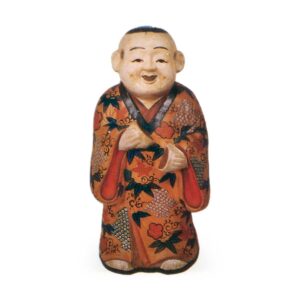
Clay toys from Fushimi, Yamashiro Province (Fushimi-ku, Kyoto). It was the center of clay doll production in Japan, but there is no record of its origin. According to one theory, when the Emperor Taruhito forbade the use of haniwa (clay figurines) for the purpose of death at the hands of his successor, Nomi-no-Sukune, the Fushimi dolls originated in the Fushimi area, where a haniwa (clay figurine) craftsman from Izumo, Japan, was invited by Nomi-no-Sukune to reside. In February 711, the god Inari appeared on a peak in Yamashiro and later became known as Fushimi Inari. It is said that Kouemon Ikaruga came to this area in 1615 and made clay dolls, and is generally regarded as the founder of Fushimi clay dolls, but in fact, even his existence is doubtful. In short, it is clear that earthenware has existed in this area since ancient times, but there is still no proof as to when the clay figurines were first produced.
However, records of Fushimi clay figurines appear as early as the Genroku period (1688-1704), and they were at their peak during the Bunka-Bunsei period (1804-30). The best examples generally belonged to the period before Ansei (1854-160), and were made using expensive mineral pigments, painted on the reverse side, or with elaborate twists and turns. In the early days, the types of dolls were denpo, yuzu denpotsupo, fox, mukuro, Saigyo, oyama, cow, earthen bells, etc. Later, there were many more, including tomobiki dolls, naritaya dolls, sumo, horse, bun-eating, choko, oboko, and hundreds of others. From the end of the Edo period to the beginning of the Meiji period, there were about 50 kilns mainly in Fukakusa, which is located on the Fushimi Highway, but the number gradually declined, and by the beginning of the Showa period, there were only about 10 kilns left. (Honcho Toki Novela, Egei Ryori, Kogei Kagami, Nihon Toki Shi Ron, Nihon Kodoki, Fushimi Ningyo, etc.)



